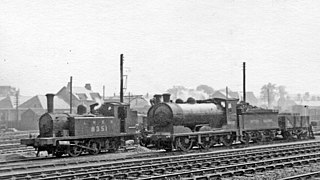Related Research Articles
Sir Vincent Litchfield Raven, KBE was an English railway engineer, and was chief mechanical engineer of the North Eastern Railway from 1910 to 1922.

The London and North Eastern Railway (LNER) Peppercorn Class A1 is a type of express passenger steam locomotive. Forty-nine original Peppercorn Class A1s were built to the design of Arthur Peppercorn during the early British Railways era, but all were scrapped with the discontinuation of steam, with none of the original production run surviving into preservation. In 2008, a brand new 50th Peppercorn A1 locomotive, 60163 Tornado, was completed.

The NBR C Class is a class of 0-6-0 steam locomotives designed by Matthew Holmes for freight work on the North British Railway (NBR). They were introduced in 1888 with inside cylinders and Stephenson valve gear. A total of 168 locomotives was built, of which 123 came into British Railways ownership at nationalisation in 1948. This was the last class of steam engine in service in Scotland.

The London and North Eastern Railway Class J38 was a class of steam locomotive designed for freight transport. They were designed by Nigel Gresley and introduced in 1926. A total of 35 were built at the LNER's Darlington Works in 1926 and they were used in Scotland. All passed into British Railways ownership in 1948 and they were renumbered from 5900–5934 to 65900–65934.

Dugald Drummond was a Scottish steam locomotive engineer. He had a career with the North British Railway, LB&SCR, Caledonian Railway and London and South Western Railway. He was the older brother of the engineer Peter Drummond, who often followed Dugald's ideas in his own work.
William Paton Reid, CBE was apprenticed to the Cowlairs railway works of the North British Railway in 1879 and was Locomotive Superintendent from 1903 to 1919. He was appointed a CBE in 1920. He was born, and died, in Glasgow, Scotland.

Matthew Holmes was Locomotive Superintendent of the North British Railway from 1882 to 1903.

The Great Central Railway Class 8H was a class of 0-8-4T steam tank locomotives designed by John G. Robinson for hump shunting at Wath marshalling yard.
Thomas Wheatley (1821–1883) was an English mechanical engineer who worked for several British railway companies and rose to become a Locomotive Superintendent at the London and North Western Railway (LNWR) and the North British Railway (NBR).
The North British Railway was opened in 1846 as the line from Edinburgh to Berwick-upon-Tweed, and its workshops were initially situated in St. Margarets, Edinburgh. Gradually other railways were acquired, including in 1865 the Edinburgh and Glasgow Railway, whose works at Cowlairs, Glasgow were better than that at St. Margarets, which were reduced to repairs only and all production moved to Cowlairs.
The NBR Class M was a class of 4-4-0 steam locomotive of the North British Railway. The class was created during the tenures of William P. Reid and Walter Chalmers by rebuilding three earlier types, the "574", "633", and "729", which had all been designed by Matthew Holmes, and shared many features in common. A total of 48 were produced.
Walter Mackersie Smith (1842–1906) was a Scottish engineer who made an important contribution to the development of the compound steam locomotive. His middle name has sometimes been mis-spelt Mackenzie. He was born at Ferry-Port on Craig, Fife.

The NBR J Class , commonly known as the Scott class, were a class of 4-4-0 steam tender locomotives designed by William P. Reid for the North British Railway. They passed to the London and North Eastern Railway at the grouping in 1923. Forty-three were built, of which thirty-five survived into British Railways ownership in 1948.
Thomas Edward Hett Heywood was a British engineer. During his career, he worked for the Taff Vale Railway, the Burma Railway Company, the Great North of Scotland Railway and the London and North Eastern Railway (LNER).

The NBR D Class was a class of 0-6-0 tank locomotives designed by Matthew Holmes for short distance freight, station pilot, and heavy shunting duties on the North British Railway.

The NBR A Class (London and North Eastern Railway Classes N14 and N15 were the standard 0-6-2 tank locomotives designed by William P. Reid for freight duties on the North British Railway. The LNER regarded the original locomotives as two separate classes. The final batch of locomotives was on order at the time of the grouping in 1923.

The North British Atlantic, later known as NBR Class H, and then as LNER Class C11 was a class of 4-4-2 steam locomotive of the North British Railway. The class was designed by William P. Reid, Locomotive Superintendent of the NBR, and entered service under his direction. They were the heaviest, longest, and most powerful locomotives ever employed on the North British Railway.

The NBR Class N was a class of 4-4-0 steam locomotive of the North British Railway. The class was designed by Matthew Holmes and later rebuilt by Holmes's successor, Reid. A total of 12 were produced.
The NBR Class D was a class of 0-6-0 steam locomotive of the North British Railway, often known as the Wee Drummonds. The class was designed by Dugald Drummond. A total of 101 were produced.

The NBR F Class was a class of 0-6-0 tank locomotives, designed by William P. Reid on the North British Railway. They were used for dockyard shunting duties.
References
- ↑ Walter Chalmers
- ↑ Thomas, John (1972). The North British Atlantics. David and Charles. ISBN 0-7153-5588-0.
- ↑ The Holmes D31 (NBR Class M) 4-4-0 Locomotives
- ↑ Ian Allan ABC of British Railways Locomotives, 1948 edition, part 4, page 18